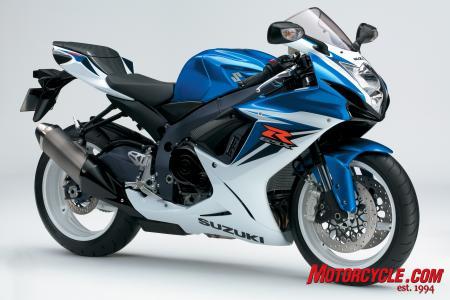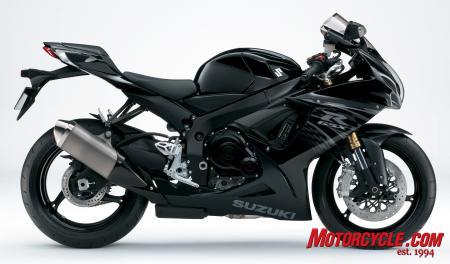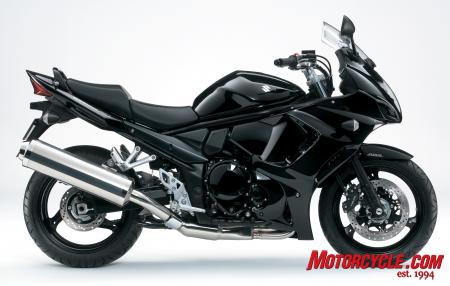
Suzuki is one of the first manufacturers to announce its initial wave of 2011 motorcycles. Go-fast riders will be happy to see the 2011 Hayabusa on the list.
“We are excited to launch a significant number of new units for the 2011 model year, while at the same time we celebrate a half-century of racing,” said Steve Bortolamedi, Senior Communications Manager at American Suzuki. “Our products are truly the result of time spent on racetracks all over the world.”
Suzuki is bringing back its popular adventure touring motorcycle, the 2011 V-Strom 650 ABS, to go along with its dual-sporting options, the 2011 DR650SE and 2011 DR-Z400S.
Cruiser motorcycle fans will be glad to know there are new versions of Suzuki’s vaunted power cruiser, the 2011 Boulevard M109R and Boulevard M109R Limited. The M109R got a few cosmetic touch-ups, like a new instrument cluster with a digital tach and LED indicator light, a gear position indicator, and the relocation of the cluster from the handlebars to the top of the headlight cowl. Joining them on the cruiser-side of things is the commuter-friendly, entry-level offerings of the 2011 Boulevard S40 and 2011 TU250.

It's good to see Suzuki back in the game with a full line-up of 2011 motorcycles set to hit dealership floors soon. Two of its most popular street models, the motorcycle that helped define the power cruiser segment, the M109R (above) and its popular adventure touring motorcycle, the V-Strom (below) are among Suzuki's 2011 offerings.

For the dirt, Suzuki has updated its race-winning motocross bikes, the 2011 RM-Z250 and 2011 RM-Z450. According to Suzuki’s website, the RM-Z450 “now meets a stricter AMA noise limit (94db) while keeping smooth engine output; the compression ratio has been increased from 12.2:1 up to 12.5:1 for higher output; intake and exhaust timing has been changed for better engine feeling with lower noise output; and ECU settings have been updated for more linear acceleration and improved over-rev.” Meanwhile, the RM-Z250 “now meets a stricter AMA noise limit (94db) while maintaining smooth engine output; the intake and exhaust timing has been changed for better engine feeling with lower noise output; the exhaust pipe length has been changed for better engine feeling with lower noise; ECU settings have been updated for more linear acceleration and improved over-rev; and the radiator hose routing has been changed for more efficient cooling.” Suzuki is also releasing a 2010 RM85.
The Japanese manufacturer also announced the next wave of 2011 ATV models – the 2011 KingQuad 400ASi, the KingQuad 400FSi and the new 2011 KingQuad 500AXi. The KingQuad 400 models have been revised with a new EFI system and a digital speedometer. The KingQuads will be available in a combination of color schemes like black, white, yellow and is also available in Realtree Hardwoods HD-enhanced camouflage. A non-power-steering version of the KingQuad 500AXi is a completely new offering for 2011.

For 2011 Suzuki has taken the reigning FIM/AMA Supercross Championship winning RM-Z450, and have fine-tuned it into an even more potent machine. The 2011 RM-Z450 has undergone numerous updates: it now meets a stricter AMA noise limit (94db) while keeping smooth engine output; the compression ration has been increased from 12.2:1 up to 12.5:1 for higher output; intake and exhaust timing has been changed for better engine feeling with lower noise output; and ECU settings have been updated for more linear acceleration and improved over-rev. In addition, Suzuki has also focused on making tuning and maintenance easier on the 2011 RM-Z450; two optional couplers come with the unit to change the EFI setting (richer and leaner), and a convenient fuel line cap is included for regular maintenance.
What you have with the 2011 RM-Z450 is a cutting-edge open-class motocross ride that’s more potent than ever. As a racer, you want quick, laser-accurate steering and confidence-inspiring high-speed handling in one package. And you want a high performance machine with a racing pedigree that enables it to be competitive right out of the crate. Here in the U.S. and around the globe, the RM-Z450 has helped racers collect wins and trophies, fiercely competing in venues from the World MX1 series to America’s AMA Supercross championship. It’s no secret that Champions Choose Suzuki!
Key Features
• For 2011, the RM-Z450 meets stricter AMA noise limit (94db) while keeping smooth engine output.
• Suzuki’s class-leading fuel-injection system uses technology from Suzuki’s championship-winning models-the GSX-R motorcycles and the QuadRacer R450 ATV. The RM-Z450, the first motocross bike to ever use fuel injection, has won both outdoor championships as well as a Supercross championship.
Engine Features
• The RM-Z450’s 449cc four-stroke, liquid-cooled, DOHC, four-valve, fuel-injected engine was developed and refined to deliver phenomenal idle-to-redline thrust.
• The lightweight, battery-less, motocross-use electronic fuel injection system uses progressive throttle linkage for efficient power delivery.
• A 12-hole fuel injector delivers a fine fuel/air mist for efficient operation.
• The RM-Z450’s aluminum cylinder is treated with Suzuki Composite Electrochemical Material (SCEM) coating, and was built for durability, light weight and efficient heat transfer.
Transmission Features
• A 5-speed transmission provides extra flexibility, offering gear ratios suited for various terrains and conditions.
• The RM-Z450 has a link-type shifting system, which offers smooth transitions through the gears.
Chassis Features
• The RM-Z450’s slim chassis design makes for a comfortable riding position, opening up the cockpit to help allow the rider to actively take control of the machine.
• Class-leading 47mm Showa inverted forks provide optimum wheel travel and are compression- and rebound-damping adjustable.
• A Showa piggyback-reservoir rear shock with high/low-speed compression damping adjustment and rebound damping and spring preload adjustments. The rear shock, working through Suzuki’s superlative rising-rate linkage system, provides 310mm of wheel travel, delivering maximum traction.
• The RM-Z450’s twin-spar aluminum frame and swingarm was developed and refined for a highly optimized balance between rigidity and superb high-speed traction. The lightweight swingarm helps enhance terrain-traversing performance over bumps.
• Race-inspired disc rotors offer enhanced cooling performance and efficient mud slinging.
• A stylish two-tone radiator shrouds accentuate the RM-Z450’s agile looks.
• The RM-Z450 comes with a gripper seat, with projected cross-shaped patterns on the top surface to provide additional grip.
MSRP $8,149
Engine:
Displacement 449cc, 4-stroke, liquid-cooled, single cylinder, DOHC
Fuel System Suzuki fuel injection
Starter Primary kick
Ignition Electronic ignition (CDI)
Chassis:
Overall Length 2190 mm (86.2 in)
Overall Width 830 mm (32.7 in)
Wheelbase 1495 mm (58.9 in)
Ground Clearance 325 mm (12.8 in)
Seat Height 955 mm (37.6 in)
Curb Weight 113 kg (249 lbs)
Transmission 5-speed constant mesh
Final Drive Chain, DID520MXV4, 114 links
Suspension Front Telescopic inverted, coil spring, oil damped
Suspension Rear Swingarm, link type, coil spring, oil damped
Brakes Front Disc brake
Brakes Rear Disc brake
Tires Front 80/100-21 51M, tube type
Tires Rear 110/90-19 62M, tube type
Fuel Tank Capacity 6.2 L (1.6 US gallons)
Suzuki is pleased to announce its first big wave of several new models for the 2011 model year. In addition to the launch of these new motorcycles and ATVs, American Suzuki is also celebrating its 50th anniversary of international racing this summer. "We are excited to launch a significant number of new units for the 2011 model year, while at the same time we celebrate a half-century of racing," said Steve Bortolamedi, Senior Communications Manager at American Suzuki. "Our products are truly the result of time spent on racetracks all over the world," Bortolamedi adds.

Suzuki is also announcing more ATV models for the 2011 model year, including the 2011 KingQuad 400ASi, the KingQuad 400FSi and the new 2011 KingQuad 500AXi. These models come hot on the heels of the previously announced 2011 KingQuad 750AXi and 750AXi Power Steering and 2011 KingQuad 500AXi Power Steering.

Suzuki also announces several new ATV models for 2011. The KingQuad 400 models have been revised and both the 400ASi and 400FSi boast a new EFI system and a digital speedometer. The KingQuad 400ASi is offered in black, white, yellow and is also available in Realtree Hardwoods HD enhanced camouflage. The 2011 KingQuad 400FSi is also available in the same variety of color schemes as the KingQuad 400ASi. Suzuki will offer a completely new offering for 2011; a non-power-steering KingQuad 500AXi, which is available in yellow, black, white and Realtree Hardwoods HD enhanced camouflage.
The 2011 GSX-R600 has been overhauled from top to bottom, losing around 20 lbs in the process. |
An all-new frame underpins the GSX-R revisions, trimmed by nearly 3 lbs on its own. This, plus a plethora of other weight-saving items, has resulted in a Gixxer some 20 lbs lighter than previous. An anticipated 410-lb curb weight (full of 4.5 gallons of fuel) would tie the Gix Six with the class lightweight, Honda CBR600RR.
Smaller front and rear axles and wheel hubs are claimed to reduce weight by a significant 1.3 lbs, and the fully adjustable Showa shock now uses aluminum seats instead of steel for a 90-gram reduction in weight.
Although final specifications aren’t yet available, it appears as if the previous bike’s steering geometry numbers are retained. However, the new frame (with sections as thin as 3mm) tightens up the wheelbase by 15mm. A new swingarm is the same length as previous, but it’s now constructed from three melted/gravity-cast sections instead of five high-pressure plate castings.
Powertrain
The GSX-R’s 599cc mill is architecturally unchanged, retaining the same bore and stroke (67.0 x 42.5mm) as the existing bike and every other 600 supersport. But everything inside has been updated, and the motor has been rotated 3 degrees more upright. It’s also a massive 4.4 lbs lighter.
Shorter-skirt pistons have 14% less mass, and the connecting rods are 12% lighter. New cams with reduced overlap are purported to boost low- to mid-range power, and they continue to actuate 16 titanium valves. New vent holes between cylinders reduce mechanical pumping losses.
Suzuki Dual Throttle Valve (SDTV) technology carries over, now better directing fuel into the combustion chamber via a steeper angle of the throttle bodies to improve responsiveness. A smaller ECU shaves 330 grams of weight and allowed it to be relocated in front of the airbox. Suzuki Drive Mode Selector (S-DMS) now has just two settings instead of three, and the softer setting now defaults to full power when the throttle is pinned.
A considerable 3.75 lbs was pared from the exhaust system’s weight, thanks to thinner-wall header tubing and a smaller under-engine pre-chamber and titanium muffler. Fuel economy is said to be improved by 10%, somewhat offset by the new requirement for premium gas.
We’re told to expect 123 crankshaft horsepower delivered at 13,500 rpm, which should translate into about 108 horses at the rear wheel. This should put it at or near the top of the herd. Torque peaks at 11,500 rpm with 51.3 ft-lb measured at the crankshaft.
The transmission has its internal gearing juggled, now with a slightly taller first gear and closer spacing throughout its six speeds. Suzuki reps allege smoother shifting along with the gearbox being 185 grams lighter.
Ergonomics
The GSX-R600 retains the lowest-in-class seat height of 31.8 inches, and its narrower shape allows short legs a direct path to the ground. The clip-on handlebars are now spread out 1 degree extra for better leverage, and a lower tank top allows easier tucking in. Footpegs retain their class-exclusive three-position adjustability and are lighter by 53 grams.
A compact instrument panel is borrowed from the GSX-R1000, now including a lap timer and a four-step adjustable shift light. A large analog tach is augmented by an LCD panel with speed, gear position, clock and dual tripmeters.
Style and Bodywork
Although there is nothing revolutionary about the Gixxer new styling, the bodywork has special appeal beyond its sporty appearance and shorter overhangs. Suzuki has somehow clipped off 7.5 lbs from the plastic, partially by reducing the piece count from 40 to 32. As previous, props go to Suzuki for having cleanly integrated turn signals. The fronts are in the mirrors; the rears are sculpted into the tailsection.
The 2011 GSX-R600 seems to have all the ingredients to vault it to the top end of the 600cc sportbike class, and we’re excited to sample it to find out how well its lighter weight and Brembo brakes work early in the New Year.
“It’s hard for me to explain the leap we made with this model,” said Derek Schoeberle, American Suzuki’s field service manager and one of the few people outside Japan to have ridden the new Gixxer.
This exciting new GSX-R is scheduled to arrive in dealers in February or March for a list price of $11,599. You’ll have your choice of the familiar Suzuki blue and white or a black-and-silver combo.
 The GSX-R600 looks more finely finished than ever. The GSX-R600 looks more finely finished than ever. |
2011 Suzuki GSX-R750
The 749cc version of the Gixxer 600 makes an appreciated companion, sharing virtually all the updates its little brother inherited this year. It, too, has lost about 20 lbs, now with a stated curb weight of 416 lbs – that’s just 6 lbs more than the 600.
But the best news is that Suzuki has juggled the 750’s MSRP in relation to the 600. Instead of the $1300 difference in 2009, the added cost for the 750cc version is now just $400!
 The 2011 GSX-R750 profile shows its blunter nose and redesigned exhaust. MSRP is $11,999, only 400 clams more than the 600 but with 20% extra power! The 2011 GSX-R750 profile shows its blunter nose and redesigned exhaust. MSRP is $11,999, only 400 clams more than the 600 but with 20% extra power! |
The GSX-R750’s engine is a bored and stroked (70.0 x 48.7mm) 600 motor, and it’s reputed to produce 148 crankshaft hp at 13,200 rpm, which should translate into 130-plus ponies at the rear wheel.
This amount of power in a 400-lb chassis will undoubtedly translate into serious fun on the racetrack, especially when considering the shorter and lighter chassis and Brembo equipment.
2011 Suzuki GSX1250FA
The other new bike we saw the Suzuki dealer meeting – with 600 dealers and 1400 attendees – is an update on the venerable Bandit 1250, now in a fully faired sporty-touring iteration.
The Bandit was last seen in Suzuki’s 2008 lineup, and this new version, called the GSX1250FA, takes it up a level. It’s a bike that was introduced in world markets in 2010, but it’s a new addition to American Suzuki’s lineup.
And it looks like a bike right for these times, as it offers real-world usability, long-distance comfort , a midrange-heavy big-bore motor and anti-lock-braking safety, all at a very reasonable list price of $11,599.
 The 2011 GSX1250FA takes the Bandit to a sleeker, sport-touring angle with its full fairing and standard ABS brakes. The 2011 GSX1250FA takes the Bandit to a sleeker, sport-touring angle with its full fairing and standard ABS brakes. |
The FA uses a 1255cc four-cylinder for power, fuel-injected for quick response and counterbalanced for smoothness. The Bandit ST (my words)’s chassis is a basic steel-tube frame, with its rake and trail a moderately sporty 25.2 degrees and 104mm, respectively, scaling in at 567 lbs full of fuel.
Utility is promised by the standard-equipment centerstand and availability of hard luggage, including a tail trunk. The protective bodywork and windscreen will send air around its rider while draining its 5.0-gallon fuel capacity. The FA’s broad seat is comfortably low at 31.7 inches, and, if more legroom is needed, it can be raised nearly an inch by flipping its platform.
This is a lot of bike for less than 12K, even if the old Bandit retailed for less than $9000, as prices for Japanese motorcycles keep on climbing due to an unfavorable exchange rate. It’s easy to see how the GSX will appeal to aging sportbike pilots.
And with the introduction of the new Kawasaki Ninja 1000 that rings in at $12K, we’ll have to schedule a shootout when we first see the GSX1250FA in December.





No comments:
Post a Comment